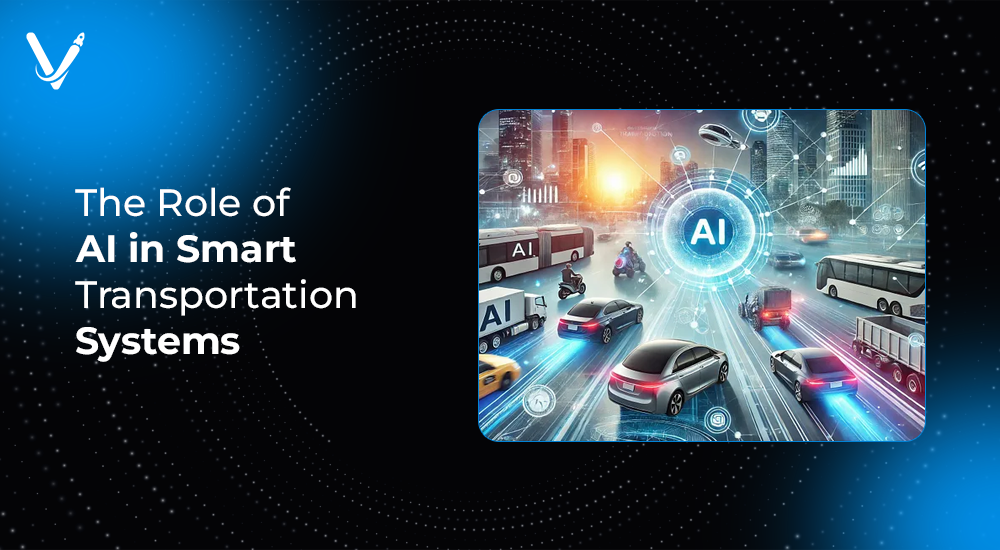The Role of AI in Smart Transportation Systems


- Apr 18, 2025
As cities grow more crowded and the demands on infrastructure increase, the need for smarter, more efficient transportation systems has become urgent. Traffic congestion, pollution, and road safety are just a few of the many challenges urban centers face today. Enter artificial intelligence (AI) — a game-changing technology poised to revolutionize how we move people and goods. AI in smart transportation is not merely a futuristic concept; it is already being embedded into the systems that power our cities.
This blog explores the multifaceted role of AI in smart transportation systems, highlighting its transformative impact on urban mobility.
Smart transportation systems refer to a network of integrated technologies that enhance the efficiency, safety, and sustainability of transportation networks. These systems leverage the Internet of Things (IoT), big data analytics, cloud computing, and, most importantly, artificial intelligence.
By enabling real-time data exchange among vehicles, infrastructure, and traffic management systems, smart transportation systems optimize traffic flow, reduce emissions, and improve commuter experiences. The backbone of these advancements is AI, which processes vast amounts of data to support intelligent decision-making and automation.
AI transportation involves various technologies that work together to interpret data and make intelligent decisions:
AI is revolutionizing the transportation sector through a wide array of applications, transforming traditional systems into intelligent, adaptive, and responsive networks. These applications span across private vehicles, public transport, infrastructure management, and safety operations.
One of the most visible and impactful applications of AI transportation is traffic management. Traditional traffic systems operate on fixed schedules, often leading to inefficiencies. AI-powered systems, on the other hand, use real-time data from cameras, sensors, and GPS to adjust traffic light timings dynamically.
Machine learning algorithms predict traffic congestion and suggest alternative routes, helping to ease traffic bottlenecks. Cities like Los Angeles and Singapore have already implemented AI-based traffic control systems that have significantly reduced travel times and pollution levels.
Autonomous vehicles (AVs) are at the forefront of AI innovation in transportation. These vehicles rely on a combination of AI technologies such as computer vision, sensor fusion, and deep learning to interpret their surroundings, make decisions, and navigate safely without human intervention.
AI also enables connected vehicle technology, known as Vehicle-to-Everything (V2X) communication. Through V2X, vehicles communicate with each other and with infrastructure (e.g., traffic lights, road signs) to share information and prevent accidents. Tesla, Waymo, and other companies are leading the charge in developing fully autonomous, AI-driven cars.
Public transport systems benefit immensely from AI through enhanced efficiency and user experience. AI algorithms can analyze ridership data to optimize routes and schedules based on real-time demand, reducing wait times and improving service reliability.[
Additionally, AI powers smart ticketing systems and predictive analytics, allowing transit authorities to manage passenger flows and prevent overcrowding. Cities like London and Hong Kong have successfully integrated AI into their public transportation networks to streamline operations and enhance commuter satisfaction.
Maintaining transportation infrastructure and vehicles is critical for safety and reliability. AI enables predictive maintenance by analyzing data from sensors embedded in trains, buses, and other infrastructure components.
By identifying patterns that indicate wear and tear or impending failure, AI systems allow operators to schedule maintenance proactively. This not only minimizes service disruptions but also extends the lifespan of expensive assets, leading to significant cost savings.
The integration of AI into smart transportation systems offers a wide array of tangible benefits that contribute to the overall improvement of urban mobility and quality of life.
Reduced Congestion and Emissions: By analyzing real-time traffic data and predicting congestion patterns, AI systems can optimize traffic flow across cities. Dynamic routing suggestions and adaptive traffic signal controls reduce idle times and vehicle clustering. This not only speeds up travel but also results in fewer emissions, aiding efforts to combat air pollution and climate change.
Enhanced Commuter Experience: AI personalizes and streamlines the journey of commuters. From real-time transit updates and smart ticketing systems to predictive route adjustments, travelers receive accurate and timely information, making their trips smoother and more convenient. AI-powered chatbots and virtual assistants further enhance customer service by resolving queries quickly.
Improved Road Safety: AI-driven surveillance and monitoring tools can detect dangerous behaviors, identify accident-prone zones, and issue real-time alerts to drivers and traffic authorities. In autonomous vehicles, AI is crucial for making split-second decisions to avoid collisions, ensuring a safer driving environment for all road users.
Efficient Infrastructure Management: With predictive maintenance, AI enables city planners and transportation authorities to monitor the condition of roads, bridges, and vehicles. By forecasting maintenance needs before problems arise, AI reduces unexpected breakdowns and costly emergency repairs, ensuring smooth and uninterrupted service.
Data-Driven Decision Making: One of AI's most powerful attributes is its ability to generate insights from massive datasets. Transportation agencies can leverage these insights to plan new infrastructure projects, optimize fleet operations, and design more efficient public transit networks based on actual usage patterns and needs.
In summary, AI enhances the reliability, efficiency, and sustainability of transportation systems, transforming them into responsive, adaptive, and user-centric networks that serve both people and the planet.
Singapore: The country has implemented AI-powered traffic systems that adapt in real-time to traffic conditions, significantly improving travel times and reducing emissions.
Waymo (USA): Waymo’s self-driving taxi service showcases how AI can safely navigate urban environments and offer autonomous mobility.
European Smart Public Transport: Cities like Helsinki and Amsterdam use AI to optimize public transport routes and schedules, improving service efficiency. San Francisco Smart Parking: The city uses AI to monitor parking availability and guide drivers via mobile apps, reducing congestion.
The future of AI in smart transportation is incredibly promising. Emerging technologies such as 5G, digital twins, and edge computing are set to enhance AI capabilities further. We can expect more personalized, responsive, and fully autonomous urban mobility systems.
Governments and private companies are increasingly investing in AI-driven transportation solutions. Innovations like AI-powered flying taxis, hyperloop systems, and mobility-as-a-service (MaaS) platforms are on the horizon, promising to redefine how we think about movement. To realize this vision, ongoing research, open data initiatives, and inclusive policy frameworks will be essential.
AI is no longer a futuristic buzzword; it is a present-day enabler of smarter, safer, and more sustainable transportation systems. From managing traffic to powering autonomous vehicles and enhancing public transit, AI is reshaping how cities operate and how people move. As we look to the future, embracing AI will be key to solving the mobility challenges of tomorrow and building a more connected and efficient world.
At Vasundhara Infotech, AI development company, we specialize in building innovative AI-driven solutions tailored for smart cities and modern transportation networks. Whether you're looking to optimize traffic systems, enhance public transit, or develop cutting-edge mobility platforms, our team is ready to help you transform your vision into reality.
Get in touch with us today to explore how AI can revolutionize your transportation initiatives.. From managing traffic to powering autonomous vehicles and enhancing public transit, AI is reshaping how cities operate and how people move.
As we look to the future, embracing AI will be key to solving the mobility challenges of tomorrow and building a more connected and efficient world.
Copyright © 2026 Vasundhara Infotech. All Rights Reserved.
